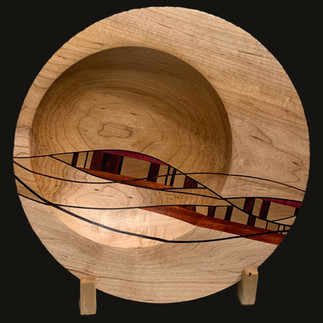About the Artists in the Ways of Wood
- The Artists Hand

- Aug 16, 2024
- 3 min read

Lew Kaminski, Robert Gordon III, Justin Coffee, Sharon Boykiw, Dennis Nebgen, Russell Schall, Barry Poglein, and Alan Luckey join us in this new exhibit with the Rural Pennsylvania Arts Alliance. Want to know more about them? Here are a few of their artistic statements in reflection of this exhibit!
Russell Schall:
"-"
Lew Kaminski:
"Whitling as a cub-scout, carving as a young adult, to Fine Art Sculpture at a wise old age, my passion remains sculpting wood."
Robert Gordon III:
"Robert is passionate about his work as a violin maker and is committed to promoting his trade and the arts in general in the community that he serves. Instruments are made in the traditional hand-tooled method, patterned after the great makers. He is an avid supporter of live music and hosts traditional acoustic music circles as well as promoting additional events throughout the year."
Justin Coffee:
"My preferred work is turning wood pieces on a lathe. I started with a project to make myself a set of chess pieces, which then evolved into pens bowls, vases, and ornaments. Recently, I’ve been inspired by architecture and creating turned items that depict buildings, especially with domes. I don’t like to use stains or paints that cover the natural wood grain, so I have been working with translucent dyes that allow for bright colors while allowing the wood grain to show through. I’ve used this technique with my architectural domes as well as globes, trees, and other scaled representations of natural items."
Sharon Boykiw:
"My work with wood is a natural extension of my ties to wooded and local landscapes, and my interest in conveying and preserving these scenes through my paintings. It is my hands-on approach to taking a salvaged piece of lumber and finding the beauty that lies under the surface. I have an understanding and respect of working with wood as a living entity. The process involves design and careful planning and measurement, along with creative problem solving, and an aptitude for working in three dimensions. Because the origin is a living tree, the piece continues to change after completion based on climate and the seasons. I find there is something very circle-of-life and grounding in this process."
Dennis Nebgen:
"I was a toolmaker by trade, but have always dabbled with woodworking. Mostly flat items as I thought wood turning was chair legs and stairway spindles. As a result, my dad’s wood lathe sat in the corner covered by dust and debris. During the winter of 2017/2018 I was watching some you-tube videos and one came on of a person turning a wooden bowl on a wood lathe. I rescued dad’s old wood lathe from the dust corner and began a journey into wood turning. It has become a passion, even an addiction I have come to love."
Barry Poglein:
"The three pieces before you were created from forest dried slippery elm using a craftsman tilt-head bandsaw. Cuts were made using a 1/8th inch blade tuned to E-minor. Entering the third cut, the blade is working beyond it's life and burns through the wood. Up to 10 blades may be used to complete the piece. Cuts are angled, 3D jigsaw type allowing removal from one direction only. Some spindle cuts are swirled through the wood with side pressure to belly the cut in the center. Spindles can be lifted or lowered but cannot be removed. Each box required at least 80 hours of design and fabrication time to complete. Pay close attention while disassembling...as...reassembly is required upon completion. Enjoy!"
Alan Luckey:
"As an educator, musician, and builder of airplanes, guitars, furniture, and houses, I draw on over six decades of diverse life experiences that have shaped my artistic expressions. Woodworking is the primary focus on my artistry. Though I am fundamentally a pragmatist - emphasizing function and usability - I also demand that my creations embody beauty. Wood allows me to transform a rigid and unyielding medium into fluid, smooth lines and to infuse surfaces with intricate detail. Over the years, I have equipped my woodshop with essential tools and prefer to design using pencil and paper rather than computer-generated images or production tools. The Arts and Crafts movement of the early 20th century, often known as the 'craftsman' or 'mission' style, has always deeply resonated with me. My home is adorned with furniture, pottery, visual art, and poetry from or reminiscent of this era. Like the artisans of the Arts and Crafts movement, I strive to engage all my senses in the creation of my art. When people interact with my work, my hope is that they perceive simplicity, strength, and beauty."










Comments